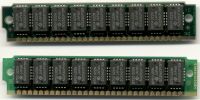Difference between revisions of "Single Inline Memory Module"
From Computer History Wiki
m (+cat) |
(A type of daughter-card) |
||
| (One intermediate revision by the same user not shown) | |||
| Line 1: | Line 1: | ||
[[Image:30 pin simm.jpg|thumb|right|200px|Two 30pin SIMMs]] | [[Image:30 pin simm.jpg|thumb|right|200px|Two 30pin SIMMs]] | ||
| − | A '''Single Inline Memory Module''' (usually abbreviated to '''SIMM''') was a standard [[main memory]] technology | + | A '''Single Inline Memory Module''' (usually abbreviated to '''SIMM''') was a standard [[main memory]] technology from the early [[Pentium]] era. They consisted of memory [[integrated circuit|chips]] mounted on a small standard-format [[printed circuit board]] [[daughter-board]] which would snap in place in a [[socket]] on the machine's [[motherboard]]. |
| − | + | These were far easier to install, remove and upgrade than the old sets of [[Dual Inline Package|DIP]] memory chips. SIMMs were typically denominated by how many [[pin]]s they had, with the common types being 30-pin and 72-pin SIMMs. | |
| − | |||
| − | SIMMs were typically | ||
{{semi-stub}} | {{semi-stub}} | ||
[[Category: Components]] | [[Category: Components]] | ||
Latest revision as of 15:46, 22 October 2024
A Single Inline Memory Module (usually abbreviated to SIMM) was a standard main memory technology from the early Pentium era. They consisted of memory chips mounted on a small standard-format printed circuit board daughter-board which would snap in place in a socket on the machine's motherboard.
These were far easier to install, remove and upgrade than the old sets of DIP memory chips. SIMMs were typically denominated by how many pins they had, with the common types being 30-pin and 72-pin SIMMs.
